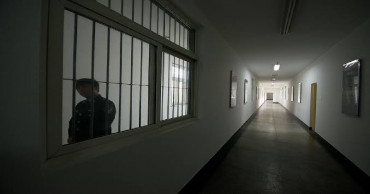national security
China warns of artificial intelligence risks, calls for beefed-up national security measures
China's ruling Communist Party has warned of the risks posed by advances in artificial intelligence while calling for heightened national security measures.
The statement issued after a meeting Tuesday chaired by party leader and President Xi Jinping underscores the tension between the government's determination to seize global leadership in cutting-edge technology and concerns about the possible social and political harms of such technologies.
It also followed a warning by scientists and tech industry leaders in the U.S., including high-level executives at Microsoft and Google, about the perils that artificial intelligence poses to humankind.
The meeting in Beijing discussed the need for "dedicated efforts to safeguard political security and improve the security governance of internet data and artificial intelligence," the official Xinhua News Agency said.
"It was stressed at the meeting that the complexity and severity of national security problems faced by our country have increased dramatically. The national security front must build up strategic self-confidence, have enough confidence to secure victory, and be keenly aware of its own strengths and advantages," Xinhua said.
"We must be prepared for worst-case and extreme scenarios, and be ready to withstand the major test of high winds, choppy waters and even dangerous storms," it said.
Xi, who is China's head of state, commander of the military and chair of the party's National Security Commission, called at the meeting for "staying keenly aware of the complicated and challenging circumstances facing national security."
China needs a "new pattern of development with a new security architecture," Xinhua reported Xi as saying.
China already dedicates vast resources to suppressing any perceived political threats to the party's dominance, with spending on the police and security personnel exceeding that devoted to the military.
While it relentlessly censors in-person protests and online criticism, citizens have continued to express dissatisfaction with policies, most recently the draconian lockdown measures enacted to combat the spread of COVID-19.
China has been cracking down on its tech sector in an effort to reassert party control, but like other countries it is scrambling to find ways to regulate fast-developing AI technology.
The most recent party meeting reinforced the need to "assess the potential risks, take precautions, safeguard the people's interests and national security, and ensure the safety, reliability and ability to control AI," the official newspaper Beijing Youth Daily reported Tuesday.
Worries about artificial intelligence systems outsmarting humans and slipping out of control have intensified with the rise of a new generation of highly capable AI chatbots such as ChatGPT.
Sam Altman, CEO of ChatGPT-maker OpenAI, and Geoffrey Hinton, a computer scientist known as the godfather of artificial intelligence, were among the hundreds of leading figures who signed the statement on Tuesday that was posted on the Center for AI Safety's website.
"Mitigating the risk of extinction from AI should be a global priority alongside other societal-scale risks such as pandemics and nuclear war," the statement said.
More than 1,000 researchers and technologists, including Elon Musk, who is currently on a visit to China, had signed a much longer letter earlier this year calling for a six-month pause on AI development.
The missive said AI poses "profound risks to society and humanity," and some involved in the topic have proposed a United Nations treaty to regulate the technology.
China warned as far back as 2018 of the need to regulate AI, but has nonetheless funded a vast expansion in the field as part of efforts to seize the high ground on cutting-edge technologies.
A lack of privacy protections and strict party control over the legal system have also resulted in near-blanket use of facial, voice and even walking-gait recognition technology to identify and detain those seen as threatening, particularly political dissenters and religious minorities, especially Muslims.
Members of the Uyghur and other mainly Muslim ethnic groups have been singled out for mass electronic monitoring and more than 1 million people have been detained in prison-like political re-education camps that China calls deradicalization and job training centers.
AI's risks are seen mainly in its ability to control robotic, self-governing weaponry, financial tools and computers governing power grids, health centers, transportation networks and other key infrastructure.
China's unbridled enthusiasm for new technology and willingness to tinker with imported or stolen research and to stifle inquiries into major events such as the COVID-19 outbreak heighten concerns over its use of AI.
"China's blithe attitude toward technological risk, the government's reckless ambition, and Beijing's crisis mismanagement are all on a collision course with the escalating dangers of AI," technology and national security scholars Bill Drexel and Hannah Kelley wrote in an article published this week in the journal Foreign Affairs.
2 years ago
US, Pakistan face each other again on Afghanistan threats
The Taliban’s takeover of Kabul has deepened the mutual distrust between the U.S. and Pakistan, putative allies who have tangled over Afghanistan. But both sides still need each other.
As the Biden administration looks for new ways to stop terrorist threats in Afghanistan, it probably will look again to Pakistan, which remains critical to U.S. intelligence and national security because of its proximity to Afghanistan and connections to the Taliban leaders now in charge.
Over two decades of war, American officials accused Pakistan of playing a double game by promising to fight terrorism and cooperate with Washington while cultivating the Taliban and other extremist groups that attacked U.S. forces in Afghanistan.
Islamabad pointed to what it saw as failed promises of a supportive government in Kabul after the U.S. drove the Taliban from power after the attacks of Sept. 11, 2001, as extremist groups took refuge in eastern Afghanistan and launched deadly attacks throughout Pakistan.
But the U.S. wants Pakistani cooperation in counterterrorism efforts and could seek permission to fly surveillance flights into Afghanistan or other intelligence cooperation. Pakistan wants U.S. military aid and good relations with Washington, even as its leaders openly celebrate the Taliban’s rise to power.
Read:Russia says it’s in sync with US, China, Pakistan on Taliban
“Over the last 20 years, Pakistan has been vital for various logistics purposes for the U.S. military. What’s really been troubling is that, unfortunately, there hasn’t been a lot of trust,” said U.S. Rep. Raja Krishnamoorthi, an Illinois Democrat who is on the House Intelligence Committee. “I think the question is whether we can get over that history to arrive at a new understanding.”
Pakistan’s prime minister, in remarks Friday to the U.N. General Assembly, made clear there is a long way to go. Imran Khan tried to portray his country as the victim of American ungratefulness for its assistance in Afghanistan over the years. Instead of a mere “word of appreciation,” Pakistan has received blame, Khan said.
Former diplomats and intelligence officers from both countries say the possibilities for cooperation are severely limited by the events of the past two decades and Pakistan’s enduring competition with India.
The previous Afghan government, which was strongly backed by India, routinely accused Pakistan of harboring the Taliban. The new Taliban government includes officials that American officials have long believed are linked to Pakistan’s spy agency, the Inter-Services Intelligence.
Husain Haqqani, a former Pakistani ambassador to the United States, said he understood “the temptation of officials in both countries to try and take advantage of the situation” and find common ground. But Haqqani said he expected Pakistan to give “all possible cooperation to the Taliban.”
“This has been a moment Pakistan has been waiting for 20 years,” said Haqqani, now at the Hudson Institute think tank. “They now feel that they have a satellite state.”
U.S. officials are trying to quickly build what President Joe Biden calls an “over the horizon” capacity to monitor and stop terrorist threats.
Without a partner country bordering Afghanistan, the U.S. has to fly surveillance drones long distances, limiting the time they can be used to watch over targets. The U.S. also lost most of its network of informants and intelligence partners in the now-deposed Afghan government, making it critical to find common ground with other governments that have more resources in the country.
Read: Don't isolate the Taliban, Pakistan urges
Pakistan could be helpful in that effort by allowing “overflight” rights for American spy planes from the Persian Gulf or permitting the U.S. to base surveillance or counterterrorism teams along its border with Afghanistan. There are few other options among Afghanistan’s neighbors. Iran is a U.S. adversary and Central Asian countries north of Afghanistan all face varying degrees of Russian influence.
There are no known agreements so far.
CIA Director William Burns visited Islamabad this month to meet with Gen. Qamar Javed Bajwa, Pakistan’s army chief, and Lt. Gen. Faiz Hameed, who leads the ISI, according to a Pakistani government statement. Burns and Hameed have separately visited Kabul in recent weeks to meet with Taliban leaders. The CIA declined to comment on the visits.
Pakistani Foreign Minister Shah Mahmood Qureshi noted this past week that Islamabad had cooperated with U.S. requests to facilitate peace talks before the Taliban takeover and that it had agreed to U.S. military requests throughout the war.
“We have often been criticized for not doing enough,” Qureshi told The Associated Press on Wednesday. “But we’ve not been appreciated enough for having done what was done.”
Qureshi would not directly answer whether Pakistan would allow the basing of surveillance equipment or overflight of drones.
“They don’t have to be physically there to share intelligence,” he said of the U.S. “There are smarter ways of doing it.”
The CIA and ISI have a long history in Afghanistan, dating to their shared goal of arming bands of mujahedeen — “freedom fighters” — against the Soviet Union’s occupation in the 1980s. The CIA sent weapons and money into Afghanistan through Pakistan.
Read: Afghanistan’s Taliban want to address General Assembly: UN
Those fighters included Osama bin Laden. Others would become leaders of the Taliban, which emerged victorious from a civil war in 1996 and gained control of most of the country. The Taliban gave refuge to bin Laden and other leaders of al-Qaida, which launched deadly attacks on Americans abroad in 1998 and then struck the U.S. on Sept. 11, 2001.
After 9/11, the U.S. immediately sought Pakistan’s cooperation in its fight against al-Qaida and other terrorist groups. Declassified cables published by George Washington University’s National Security Archive show officials in President George W. Bush’s administration made several demands of Pakistan, from intercepting arms shipments heading to al-Qaida to providing the U.S. with intelligence and permission to fly military and intelligence planes over its territory.
The CIA would carry out hundreds of drone strikes launched from Pakistan targeting al-Qaida leaders and others alleged to have ties to terrorist groups. Hundreds of civilians died in the strikes, according to figures kept by outside observers, leading to widespread protests and public anger in Pakistan.
Pakistan continued to be accused of harboring the Taliban after the U.S.-backed coalition drove the group from power in Kabul. And bin Laden was killed in 2011 by U.S. special forces in a secret raid on a compound in the Pakistani city of Abbottabad, home to the country’s military academy. The bin Laden operation led many in the U.S. to question whether Pakistan had harbored bin Laden and angered Pakistanis who felt the raid violated their sovereignty.
For years, CIA officials tried to confront their Pakistani counterparts after collecting more proof of Pakistani intelligence officers helping the Taliban move money and fighters into a then-growing insurgency in neighboring Afghanistan, said Douglas London, who oversaw the CIA’s counterterrorism operations in South Asia until 2018.
“They would say, ‘You just come to my office, tell me where the location is,’” he said. “They would just usually pay lip service to us and say they couldn’t confirm the intel.”
London, author of the forthcoming book “The Recruiter,” said he expected American intelligence would consider limited partnerships with Pakistan on mutual enemies such as al-Qaeda or Islamic State-Khorasan, which took responsibility for the deadly suicide attack outside the Kabul airport last month during the final days of the U.S. evacuation.
The risk, London said, is at times “your partner is as much of a threat to you as the enemy who you’re pursuing.”
4 years ago
US hands Bagram Airfield to Afghans after nearly 20 years
After nearly 20 years, the U.S. military left Bagram Airfield, the epicenter of its war to oust the Taliban and hunt down the al-Qaida perpetrators of the 9/11 terrorist attacks on America, two U.S. officials said Friday.
The airfield was handed over to the Afghan National Security and Defense Force in its entirety, they said on condition they not be identified because they were not authorized to release the information to the media.
One of the officials also said the U.S. top commander in Afghanistan, Gen. Austin S. Miller, “still retains all the capabilities and authorities to protect the forces.”
Afghanistan’s district administrator for Bagram, Darwaish Raufi, said the American departure was done overnight without any coordination with local officials, and as a result early Friday dozens of local looters stormed through the unprotected gates before Afghan forces regained control.
Read:Biden vows 'sustained' help as Afghanistan drawdown nears
“They were stopped and some have been arrested and the rest have been cleared from the base,” Raufi told The Associated Press, adding that the looters ransacked several buildings before being arrested and the Afghan National Security and Defense Forces (ANDSF) took control.
“Unfortunately the Americans left without any coordination with Bagram district officials or the governor’s office,” Raufi said. “Right now our Afghan security forces are in control both inside and outside of the base.”
The deputy spokesman for the defense minister, Fawad Aman, said nothing of the early morning looting. He said only the base has been handed over and the “ANDSF will protect the base and use it to combat terrorism.”
The withdrawal from Bagram Airfield is the clearest indication that the last of the 2,500-3,500 U.S. troops have left Afghanistan or are nearing a departure, months ahead of President Joe Biden’s promise that they would be gone by Sept. 11.
It was clear soon after the mid-April announcement that the U.S. was ending its “forever war,” that the departure of U.S. soldiers and their estimated 7,000 NATO allies would be nearer to July 4, when America celebrates its Independence Day.
Most NATO soldiers have already quietly exited as of this week. Announcements from several countries analyzed by The Associated Press show that a majority of European troops has now left with little ceremony — a stark contrast to the dramatic and public show of force and unity when NATO allies lined up to back the U.S. invasion in 2001.
The U.S. has refused to say when the last U.S. soldier would leave Afghanistan, citing security concerns, but also the protection of Kabul’s Hamid Karzai International Airport is still being negotiated. Turkish and U.S. soldiers currently are protecting the airport. That protection is currently covered under the Resolute Support Mission, which is the military mission being wound down.
Read:Taliban gains drive Afghan government to recruit militias
Until a new agreement for the airport’s protection is negotiated between Turkey and the Afghan government, and possibly the United States, the Resolute Support mission would appear to have to continue in order to give international troops the legal authority.
The U.S. will also have about 650 troops in Afghanistan to protect its sprawling embassy in the capital. Their presence it is understood will be covered in a bilateral agreement with the Afghan government.
The U.S. and NATO leaving comes as Taliban insurgents make strides in several parts of the country, overrunning dozens of districts and overwhelming beleaguered Afghan security Forces.
In a worrying development, the government has resurrected militias with a history of brutal violence to assist the Afghan security forces. At what had all the hallmarks of a final press conference, Gen. Miller this week warned that continued violence risked a civil war in Afghanistan that should have the world worried.
At its peak around 2012, Bagram Airfield saw more than 100,000 U.S. troops pass through its sprawling compound barely an hour’s drive north of the Afghan capital Kabul.
The departure is rife with symbolism. Not least, it’s the second time that an invader of Afghanistan has come and gone through Bagram.
Read: US to keep about 650 troops in Afghanistan after withdrawal
The Soviet Union built the airfield in the 1950s. When it invaded Afghanistan in 1979 to back a communist government, it turned it into its main base from which it would defend its occupation of the country. For 10 years, the Soviets fought the U.S.-backed mujahedeen, dubbed freedom fighters by President Ronald Reagan, who saw them as a front-line force in one of the last Cold War battles.
When the U.S. and NATO inherited Bagram in 2001, they found it in ruins, a collection of crumbling buildings, gouged by rockets and shells, most of its perimeter fence wrecked. It had been abandoned after being battered in the battles between the Taliban and rival mujahedeen warlords fleeing to their northern enclaves.
The enormous base has two runways. The most recent, at 12,000 feet long, was built in 2006 at a cost of $96 million. There are 110 revetments, which are basically parking spots for aircraft, protected by blast walls. GlobalSecurity, a security think tank, says Bagram includes three large hangars, a control tower and numerous support buildings. The base has a 50-bed hospital with a trauma bay, three operating theaters and a modern dental clinic. Another section houses a prison, notorious and feared among Afghans.
There was no immediate comment from Afghan officials as to the final withdrawal from Bagram Airfield by the U.S. and its NATO allies.
4 years ago
No ET, no answers: Intel report is inconclusive about UFOs
A long-awaited U.S. government report on UFOs released Friday makes at least one thing clear: The truth is still out there.
Investigators did not find extraterrestrial links in reviewing 144 sightings of aircraft or other devices apparently flying at mysterious speeds or trajectories. But they drew few other conclusions and instead highlighted the need for better data collection about what’s increasingly seen by Democrats and Republicans as a national security concern. In all but one of the sightings investigated, there was too little information for investigators to even broadly characterize the nature of the incident.
There were 18 cases in which witnesses saw “unusual” patterns of movement or flight characteristics, the report said, adding that more analysis was needed to determine if those sightings represented “breakthrough” technology.
Long the domain of science fiction and so-called ufologists, the subject of UFOs has in recent years drawn serious study from the Pentagon and intelligence agencies. The prospect of an adversary spying with unknown technology has alarmed lawmakers in both parties.
Read:120,000-year-old fossils in Israel link to human family tree
Congress last year required the creation of the report delivered Friday. While its lack of conclusions has already been made public, the report on what the government calls “unidentified aerial phenomena” still represents a milestone in the study of the issue.
U.S. officials who briefed reporters on condition of anonymity said there were “no clear indications” that the sightings could be linked to alien life. There is also no definitive linkage of sightings to potentially unknown technology of an adversary like Russia or China.
“It’s clear that we need to improve our capacity to further analyze remaining UAP observations, even as we accept that there are some limits to our capacity to characterize and understand some of the observations that we have,” one official said.
The report was published online and delivered to the House and Senate intelligence committees with a classified annex. Lawmakers were given a briefing last week on the investigation. One person who attended the classified briefing and spoke on condition of anonymity said that lawmakers were given little information beyond what’s publicly available and that the only videos shown had already been made public.
The report lists five potential categories, including the possibility of foreign adversaries flying unknown technology to events occurring naturally in the atmosphere.
Read:NASA sends squid from Hawaii into space for research
But only one instance was categorized as “airborne clutter” and believed to be a large, deflating balloon. The rest are uncategorized because of a lack of information. That includes three instances of potential sightings captured on videos that were declassified and released in recent years.
The Department of Defense will over the next three months develop a new strategy for collecting and tracking information on potential sightings.
Deputy Defense Secretary Kathleen Hicks said the UAP report highlights the problem of flight hazards on or near military test and training ranges. She ordered the Pentagon’s top intelligence and security official to establish a more formal means of coordinating the collection, reporting and analysis of UAP information. This body also would make recommendations on securing military test and training ranges.
“It is critical that the United States maintain operations security and safety at DoD ranges,” she wrote in a memo released Friday. “To this end, it is equally critical that all U.S. military aircrews or government personnel report whenever aircraft or other devices interfere with military training. This includes the observation and reporting of UAPs.”
Read:Weird ‘living fossil’ fish lives 100 years, pregnant for 5
Part of the data collection effort is destigmatizing UAPs and pushing pilots to report what they see, even when what they see is implausible.
“A big problem around UAPs has been the cultural stigma,” said Rep. Andre Carson, an Indiana Democrat and member of the House Intelligence Committee, in an interview last week. “It has largely been relegated to science fiction.”
Sen. Marco Rubio, who as the top Republican on the Senate Intelligence Committee has long pushed for more disclosure about UAPs, called the report “an important first step in cataloging these incidents, but it is just a first step.”
“The Defense Department and Intelligence Community have a lot of work to do before we can actually understand whether these aerial threats present a serious national security concern,” Rubio said in a statement.
4 years ago
Biden orders review of domestic violent extremism threat
President Joe Biden has directed law enforcement and intelligence officials in his administration to study the threat of domestic violent extremism in the United States, an undertaking being launched weeks after a mob of insurgents loyal to Donald Trump stormed the U.S. Capitol.
4 years ago
Republicans acknowledge Biden’s victory
More than a month after the election, top Republicans finally acknowledged Joe Biden as the next US president on Tuesday.
5 years ago
China holding 3 Taiwanese over national security suspicions
China confirmed Wednesday that it is holding three Taiwanese on suspicion of committing subversion or other crimes against the Chinese state, part of a trend that has prompted a travel warning from the island's government.
6 years ago




.jpg)





